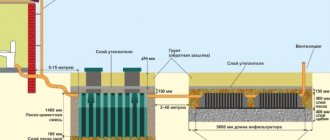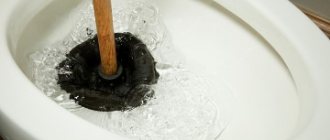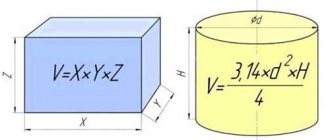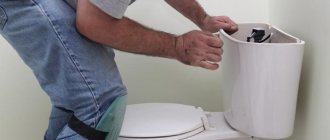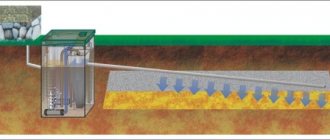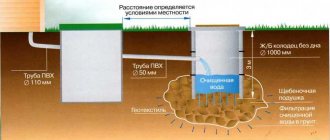Septic tanks have long become an integral part of the autonomous sewage system of country houses. And this is not strange, because using them, you get rid of many problems characteristic of traditional systems:
- Unpleasant odors.
- Insufficient capacity.
- Unsafe operation.
To fully experience all the benefits of this type of cleaning device, you must first choose a good septic tank, and also do not forget that it should be cleaned regularly.
Basic methods of pumping waste from septic tanks
Septic tank pumping is carried out using three methods, namely:
- mechanically;
- biologically;
- automatically
The first method is the most common for pumping out municipal liquid waste (LMW). For this purpose, special machines with special equipment are used. From them a pump is supplied to the cesspool, which is completely or partially immersed in the contents of the septic tank. Depends on the type of cesspools, waste, workload and other factors.
The biological method is based on the following:
- Special chemicals are poured into the septic tank. They can be either in powder form or in the form of tablets or granules;
- A chemical reaction occurs, reinforced waste products are oxidized and neutralized, and their density decreases.
This method allows you to reduce the amount of mechanical pumping several times. The method is completely suitable in the following cases:
- The cesspool is used periodically and fills slowly;
- Large volume septic tank;
- Autonomous sewerage comes into contact with a small volume of wastewater.
Automatic pumping requires special equipment. It, as in the first case, is represented by a sewage disposal machine, which has a special tank, pump and hose. However, unlike conventional special transport, relatively new technologies are used here - hydrodynamic, vacuum cleaning and suction.
It is most effective to use vacuum pumping. It does not leave any unpleasant odors, does not create specific dirt, and the procedure lasts several minutes.
With the help of hydrodynamic cleaning, not only pumping is carried out, but also the internal surface of the septic tank is cleaned. The simplest and cheapest option is a suction pump. Removes the contents of the pit along with bottom sludge.
Construction of houses
29 votes
+
Vote for!
—
Vote against!
An integral stage of suburban construction is the installation of an autonomous sewer system, the main part of which is septic tanks. Unlike traditional sewer systems, they are characterized by obvious advantages, including high capacity, environmental safety, absence of unpleasant odors, and others. Like any other storage tank, septic tanks must be periodically cleaned, and if for urban residents the question “Where does the wastewater go?” is not relevant, since the centralized sewer system carries out all of these processes unnoticed by residents, then country life obliges owners to take care of installing compact and easy-to-maintain cleaning systems. Neglecting to install this equipment can result in big problems for homeowners, since pumping out septic tanks will become not only a labor-intensive, but also a costly process. Despite the fact that on the Internet there are gigabytes of information about local wastewater treatment plants, including advertising information about models of domestic and foreign production, as well as their comparative characteristics. However, it is rare to find information regarding pumping out a septic tank with your own hands, and today we will try to fill this information gap.
Content
- The design of septic tanks and the principle of their operation
- Pumping of septic tanks and cesspools: relevance of the problem
- Methods for cleaning septic tanks: pumping and other alternatives
- Septic tank pumping: specialist services
- What must a customer provide when using the services of a specialized company?
- How to pump out a septic tank with your own hands?
- Fecal pumps: main types
- The procedure for pumping out septic tanks using a pump and hoses
The design of septic tanks and the principle of their operation
What is the principle of operation of a local country cleaning system? Oddly enough, it is quite simple and involves the flow of wastewater into various chambers - septic tanks, where their primary purification occurs with the participation of specialized microorganisms, which results in the formation of sediment at the bottom of the septic tank and liquid clarified wastewater. Due to the fact that ordinary people do not need to dive into the details of the functioning of a septic tank, we will consider a simplified diagram of the process. The first stage of purification involves gravitational settling of wastewater (occurring under the influence of its own weight), which is carried out mainly in the receiving chamber of the system and leads to the formation of heavy insoluble impurities and organic inclusions at the bottom. These include substances such as natural and synthetic fibers, sand, human waste, and often personal hygiene items. After this, the specified contents enter the settling chamber, where they are separated taking into account their specific gravity, as a result of which heavier substances settle to the bottom, and lighter substances remain on the surface. Once in the bioreactor chamber, the wastewater, which has undergone partial clarification, is inactivated by anaerobic microorganisms that oxidize and decompose the organic substances present in the wastewater in the form of a solution and organic inclusions.
Pumping of septic tanks and cesspools: relevance of the problem
Regular maintenance and cleaning are the key to the optimal functioning of autonomous sewer systems, and septic tanks, in this case, are no exception, and therefore they need regular cleaning of accumulated masses at least 1-2 times a year. Considering that a septic tank is a container equipped with filters, it must be remembered that overfilling one of them can cause clogging of the filtration elements, which can lead to failure of the entire structure. In addition, repairing equipment that has failed will cost much more than timely maintenance of a septic tank. To avoid unnecessary questions, let us clarify that the concept of “excessive cleaning of a septic tank” does not exist, and an excessive number of pumpings does not have a negative impact on the operational characteristics of an autonomous sewer system, but will only improve them.
Important! Separately, it is worth clarifying that there are situations when the septic tank is not used enough (country summer cottages and country houses) and it is not completely filled. In this case, it is necessary to pump out the septic tank at least once a year, since if this condition is not met, after several years the remaining sediment will transform into hard, heavy clay, which will be problematic to clean out without the use of specialized equipment. Sludge compressed using special equipment must be disposed of, but this process is one of the most labor-intensive. Taking into account the above, we note that the answer to the question: “Is there a need for regular pumping of the septic tank?” is quite clear, and it is definitely positive, since timely pumping of septic tanks prevents clogging of settling tank chambers and extends the operational life of the autonomous sewer system.
Pumping out septic tanks photo
Methods for cleaning septic tanks: pumping and other alternatives
The procedure for pumping out septic tanks is one of the least pleasant procedures that a private homeowner can encounter. But, despite this, it is mandatory, and everyone who does not plan on additional costs for repairing communications needs to become familiar with the features of its implementation. Despite the fact that today there are not many ways to clean a septic tank (two full-fledged and one auxiliary), each homeowner has the right to choose the most convenient one for him, guided by certain preferences.
Let's look at all the available methods for cleaning septic tanks.
- A long-standing and currently most popular method of cleaning a septic tank is the use of special equipment that ensures sufficient efficiency of work and maximum convenience of the process;
- Cleaning a septic tank yourself is not for the faint of heart. Despite the fact that there is a whole range of equipment and tools available for sale for self-cleaning septic tanks, this method is the least popular, since not everyone can decide to do it;
- Another method available to private homeowners is the use of biological products, which contain bacteria that break down the contents of cesspools and neutralize wastewater. Despite the apparent simplicity of this method, it cannot be considered complete, since the use of biological products only helps to reduce the rate of accumulation of solid sediments and reduces the frequency of cleaning septic tanks using the previous two methods.
Important! In the process of pumping out septic tank pits, not only solid sediment is removed, but also the complete pumping out of all wastewater that is currently in the septic tank, as a result of which it is completely emptied, which is categorically unacceptable. This is due to the insignificant weight of the septic tank, which can be squeezed out to the surface by the force of groundwater, which can cause damage to the entire sewer system. In this regard, after 24 hours of carrying out the appropriate manipulations to clean the septic tank, its container must be filled with water. However, remember that this manipulation is only necessary if the septic tank is made of plastic.
So that in the future, the choice of a suitable method for pumping out a septic tank is more than justified, we will consider all the currently existing options.
Septic tank pumping: specialist services
Despite the generally accepted rules, according to which it is necessary to carry out cleaning at least 1-2 times a year, it is necessary to understand that the application of any recommendations should be carried out taking into account many factors, including the model of the septic tank that is used in your autonomous sewer system, the regularity of residence families in a country house, as well as the number of people in the family. If only seasonal residence is planned in a country house, then cleaning the septic tank can be done much less frequently.
Currently, the task of homeowners planning to pump out a septic tank is greatly simplified, since they can use the services of specialized private companies, which have all the necessary equipment to carry out the relevant manipulations.
The procedure for pumping out a septic tank is not difficult for experienced specialists, but it is quite difficult for those who do not have the required qualifications and sufficient training. The procedure for cleaning a septic tank, carried out by employees of specialized companies, includes not only pumping out water and fecal matter from the septic tank, as well as removing other solid deposits, but also washing away the sludge that is deposited at the bottom of the septic tank chambers. Another necessary stage of this event is cleaning the septic tank pipes.
Important! To achieve the best result, increase the efficiency of cleaning measures and improve the performance of the septic tank, it is necessary to disinfect the septic tank using biological products containing microorganisms.
Cleaning services for autonomous sewer systems offered by specialized waste disposal companies:
- Disinfection of special equipment using biological products containing microorganisms;
- Pumping of fecal wastewater and sludge from septic tanks;
- Removal of silt and solid deposits involved in the formation of solid sediment;
- If necessary, clean sewer pipes;
- Other services, the end result of which is the achievement of sanitary standards, provided at the request of the client.
When describing this method of pumping out septic tanks (services of specialized companies), it is necessary to consider the equipment used by specialists and give a brief description of it.
- Vacuum trucks , which are also called vacuum machines. They are machines equipped with a storage tank and a powerful pump, and provide prompt and, at the same time, high-quality pumping of septic tanks. At the same time, sludge is pumped out and all unpleasant odors are removed. If the volume of deposits formed corresponds to the volume of the machine, then, thanks to its use, you will be able to carry out a full range of works necessary in this case, namely, remove all accumulated deposits, protecting the sewer system from possible breakdowns;
Despite the visible advantages of this method of pumping a septic tank, it is also characterized by certain disadvantages:
- The cost per call is quite high, and if you consider that some models require fairly frequent pumping, this can become a serious cost item in the family budget;
- If you are the owner of a private house with a small yard, then this method will not suit you for the reason that sewer trucks are large in size and often will not fit in a narrow area;
- Loud noise when machines are running. However, this inconvenience can be eliminated to some extent, since specialists can use a protective casing made of foil and thermal fiber, which is designed to absorb sounds.
- Sludge sucking machines, which are a modern type of specialized technical equipment designed for cleaning septic tanks of any size. Unlike sewer machines, sludge sucking machines are equipped with more powerful equipment, using which it is possible to pump from a depth of more than 8 meters, while being at a distance of up to 40 cm from the autonomous sewer system. In this regard, there are no additional difficulties associated with providing access to the structure. The most common volume of the machine ranges from 5 to 30 cubic meters. meters of waste. The operational characteristics of sludge suckers are such that they can be used not only for pumping fecal matter, water and sludge from a septic tank, but also for washing sewer pipes and internal elements of septic tanks using a water jet supplied under high pressure, which ensures the removal of even hardened sediment and sediments.
Important! Two types of work can be performed because the tank with which the sludge sucker is equipped has a partition that divides the container in half. In this case, two halves are formed in the container, one of which is intended for transporting water, and the other for liquid waste.
- Driven vacuum pumps equipped with a vacuum boom. A remote control is used to control the pump. Due to the fact that the pump for pumping out a septic tank is characterized by high power and the presence of hoses of various lengths and diameters, it can be used to lift already solid deposits and pump out sludge from a septic tank even at great depths.
Important! The customer should not be bothered by problems associated with the removal and disposal of sewage, since they are assigned to the companies that clean septic tanks and provide special equipment.
What must a customer provide when using the services of a specialized company?
Despite the fact that today it is quite easy to find a company specializing in this type of work, where truly competent specialists operate, and you can be sure that the services will be provided at the proper level, it will require some effort on the part of the customer, which are as follows:
- If we are talking about a conventional sewer truck, the range of which is limited, first of all, it is important to ensure optimal conditions for the vehicle to approach the site. The most successful option is considered to be the one when access to the septic tank is located in close proximity to the roadway. However, modern equipment, equipped with hoses up to 120-180 meters long, and in the case of using special high-pressure polyethylene hoses, even 500 meters, there is no need for your personal efforts to provide access to the septic tank;
- In order for specialists to make the correct selection of appropriate means for pumping out the septic tank, it is necessary to inform them of the depth and volume of the septic tank. If specialists customize a conventional sewer truck, then it is important to take into account the fact that its volume is limited, and pumping using it can be carried out at a depth of no more than 3 meters;
- It is necessary to understand that during the process of pumping out septic tanks, their contents are agitated, which causes unpleasant odors. In this regard, experts recommend taking care that other family members are not at home during the period of work.
How to pump out a septic tank with your own hands?
If the services of specialized companies providing sewage disposal equipment seem high to you, you can pump out the septic tank yourself. This task will be significantly easier if a country house equipped with an autonomous sewer system is intended only for summer residence, and therefore, filling the septic tank will occur more slowly than for year-round residence.
To carry out manual pumping of a septic tank, you will need a fecal pump, which belongs to the class of specialized equipment for pumping cesspools and septic tanks, as well as a container of the appropriate size. Sometimes inexperienced craftsmen replace the fecal pump with a regular water pump, but it quickly fails, becoming clogged with silt and solid deposits. To slow down or completely prevent pump clogging, it is recommended to use special filters that fit over the pump and prevent solid particles from entering it.
Before you start pumping out the septic tank, make sure you have a container the volume of which corresponds to the volume of the septic tank, which will allow you to remove sewage in one go. The container must be equipped with a lid that will prevent sewage from splashing out and spreading an unpleasant odor. Also decide on the place where you will drain the sewage.
Fecal pumps: main types
One of the main tools of a vacuum cleaner is a pump, but it must be clarified that a conventional suction pump is not suitable for such activities, since it is not intended for pumping contaminated liquid substances. This is due to the fact that large organic inclusions will lead to instant jamming of the impeller, and small abrasive particles such as sand and earth, if they get between the rubbing surfaces, will cause rapid equipment failure.
Important! If we talk about budget options, then one of these is a drainage pump, which can be used to pump out wastewater that is contaminated with inclusions of no more than 5 mm. This is due to the fact that its pumping mechanism is equipped with a filter mesh that retains particles.
Important! The most suitable option is fecal pumps, which were designed in such a way that in the future they would be used to work with heavily contaminated masses, and therefore, the components most susceptible to wear are made with a multiple safety margin, and are also protected from exposure to aggressive environments.
In accordance with the method of protecting the suction unit, fecal pumps are classified into the following types:
- Pumps protected by filters. They are equipped with fairly complex self-cleaning filters that are capable of trapping particles with a diameter of up to 35 mm;
- Pumps equipped with a chopper , which can be combined with an impeller or represented by a separate mechanism. The chopper operates on the principle of a meat grinder. Organic particles and household waste particles are ground until they reach safe sizes.
According to the degree of protection, they are distinguished:
- Submersible fecal pumps , characterized by a completely sealed thick-walled casing and the presence of anti-corrosion treatment;
- Semi-submersible sewage pumps are also equipped with a thick-walled casing, but lack anti-corrosion protection;
- Portable fecal pumps, unlike the previous two models, are characterized by a minimum degree of protection, minimum weight and price.
Important! Due to the indicated features of the listed models, the first two are used as stationary stations for pumping waste, and the last one can become a handy tool for a home sewer.
The procedure for pumping out septic tanks using a pump and hoses
- Before carrying out work, prepare a fecal pump, which is a special submersible model equipped with large filters and a powerful compressor, thanks to which you can quickly pump even solid waste;
- A hose corresponding to the diameter of the outlet pipe of this electrical device is connected to the pump. Otherwise, the passage of wastewater through the outlet will be difficult;
- To pump out country sewers, it is recommended to use small models with a built-in shredder, which are capable of independently purifying water from solid waste;
- After pumping has been carried out, the bulk of the wastewater is cleaned from dirt and silt from the bottom of the storage tank and filters. This activity is carried out wearing gloves using a brush and rag. In this case, the sludge is removed from the blades, the bacterial (if any) and mechanical filters are cleaned from build-up;
- The next stage of pumping out a septic tank involves washing it with water, for which the septic tank tank is filled with running water, which is also subject to pumping in the future. Carrying out this manipulation will eliminate silt deposits and minimal deposits. In order to eliminate unpleasant odors during these manipulations, it is necessary to use specialized compounds that include bacteria that break down biological waste.
Pumping septic tanks video
Why shouldn't you pump out the septic tank yourself?
You shouldn’t think about how to pump out a septic tank with your own hands. Contrary to appearances, this is not an easy task as it may seem:
- The first step is to remove the outer and inner covers. This operation must be carried out with great care, since sudden opening of the unit may lead to decompression of the gases inside the unit;
- The next step is emptying the sump. To do this, a hose for pumping out sludge is inserted into the hatch from the wastewater inlet side, and a water hose is inserted from the sump outlet side to replenish the contents of the sump. This is very important because during sludge removal, the liquid level in the sump should not be less than half the total filling height;
- After pumping out the residual sludge, special preparations are used for septic tanks and wastewater treatment plants to increase the dose of the activator. This is an important preventive treatment that allows you to maintain the rhythmic operation of wastewater treatment plants.
Decompression not only leads to shrinkage of the walls of the sump. It allows gas to quickly leak out, which can be hazardous to the health of people nearby. It will be difficult for a non-professional to prevent such a development of events. It’s cheaper and easier to order septic tank pumping.
For site users, we have compiled (and is constantly expanding) a list of organizations in large cities of Russia that pump waste from septic tanks and cesspools:
Moscow
St. Petersburg
Astrakhan Barnaul Vladivostok Volgograd Voronezh Ekaterinburg Izhevsk Irkutsk
Kazan Kaliningrad Kemerovo Kirov Krasnodar Krasnoyarsk Lipetsk Makhachkala Naberezhnye Chelny Nizhny Novgorod
Novokuznetsk Novosibirsk Omsk Orenburg Penza Perm Rostov-on-Don Ryazan Samara Saratov
Tolyatti Tomsk Tula Tyumen Ulyanovsk Ufa Khabarovsk Cheboksary Chelyabinsk Yaroslavl
How often should the septic tank be pumped out?
Domestic sewage treatment plants are not only an effective, but also a very convenient and functional solution. Thanks to it, it is possible to discharge wastewater in areas without a permanent connection to the sewerage system. Buying a purification plant at home is a profitable investment, but you should remember that it requires proper operation. Then the entire system can operate reliably for many years.
A key element of any septic tank, cesspool and water treatment plant is the settling tank, which collects the by-products of fermentation processes in the form of sediments that form on the surface of the water. The sediment that has accumulated over time interferes with the proper operation of the entire system, so periodic emptying of the sump is a necessary procedure.
The answer to the question of how often a septic tank needs to be pumped depends on the type of treatment plant and the size of the septic tank. It is recommended to empty the sediment and flush the filter cartridge reservoir once a year.
Monitoring water consumption ↑
Each time wastewater enters the chamber, the same amount of liquid enters the drainage system. The longer sewage is stored in a septic tank, the less suspended solids and organic matter there are in the effluent. Conversely, if water moves too quickly through the septic system (due to excessive household water use), the solids do not have time to settle and end up in the filtration fields. Therefore, whenever possible, it is advisable to regulate the amount of water entering the sewer, for example, it is better to distribute washing evenly on different days. You can also reduce water consumption by installing a water saving function in your plumbing equipment.
Cost of pumping a cesspool
It is generally accepted that installing a septic tank is the cheapest solution. Only the cost of its purchase and assembly is taken into account. Due to the fact that this is a long-term solution, operating costs, especially septic tank disposal, cannot be ignored.
Companies that specialize in emptying sealed tanks charge per meter of wastewater pumped or per arrival. In 2021, a one-time emptying of a septic tank costs from 1.5-2.5 to 5-6 thousand rubles. and more. Prices depend on the region, septic tank parameters, other data, including time of year.
With prices trending upward across virtually every industry in 2021, the cost of emptying a septic tank could be several percent higher. An alternative to a pit and a conventional septic tank is technologically advanced systems. It is worth considering replacing them with household wastewater treatment. This will require additional investment, but due to low operating costs, the investment will pay off in a few years.


